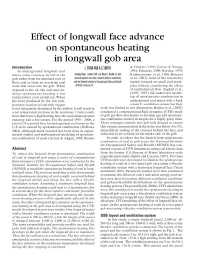Mining Publication: Effect of Longwall Face Advance on Spontaneous Heating in Longwall Gob Areas
Original creation date: March 2010
To reduce fire hazards from spontaneous combustion of coal in longwall gob areas, a series of computational fluid dynamics (CFD) simulations were conducted by the National Institute for Occupational Safety and Health (NIOSH) to model the spontaneous heating of coal in longwall gob areas. The previous modeling results demonstrate that spontaneous heating of coal usually occurred behind the longwall shields and along the face with a bleeder ventilation system. Assuming a stationary longwall face, the spontaneous heating could turn to a spontaneous fire in several days for the most reactive coal under favorable conditions. When the longwall face advances, the spontaneous heating process will be significantly affected. In this study, the effect of longwall face advance on the spontaneous heating in the gob area is investigated using the CFD model developed in previous studies. One longwall panel with a bleeder ventilation system is simulated. The width of the panel is 300 m (984 ft), while the length of the panel is changed between 1,000 to 2,000 m (3,280 to 6,560 ft). The same permeability and porosity profiles are used for gobs with different lengths. The spontaneous heating first develops in the gob when the longwall face is stationary. Then, the face advances at a certain rate. The face advance is simulated as a series of discrete movements, and the effect of the face advance on the maximum temperature developed during the face stoppage is examined.
Authors: L Yuan, AC Smith
See Also
- CFD Modeling of Spontaneous Heating in a Large-Scale Coal Chamber
- Computational Fluid Dynamics Modeling of Spontaneous Heating in Longwall Gob Areas
- Effects of Ventilation and Gob Characteristics on Spontaneous Heating in Longwall Gob Areas
- Elastic and Shear Moduli of Coal Measure Rocks Derived from Basic Well Logs Using Fractal Statistics and Radial Basis Functions
- Fire Fighting
- Numerical Study on Effects of Coal Properties on Spontaneous Heating in Longwall Gob Areas
- Simulation of Spontaneous Heating in Longwall Gob Area with a Bleederless Ventilation System
- SPONCOM - A Computer Program for the Prediction of the Spontaneous Combustion Potential of an Underground Coal Mine
- Spontaneous Combustion
- Stochastic Modeling of Gob Gas Venthole Production Performances in Active and Completed Longwall Panels of Coal Mines
- Technology News 545 - NIOSH Updates Spontaneous Combustion Assessment Software
- Content source: National Institute for Occupational Safety and Health, Mining Program


 ShareCompartir
ShareCompartir
